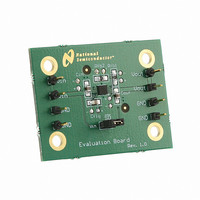LM2750LD-ADJEV National Semiconductor, LM2750LD-ADJEV Datasheet - Page 14

LM2750LD-ADJEV
Manufacturer Part Number
LM2750LD-ADJEV
Description
BOARD EVAL LM2750LD-ADJ
Manufacturer
National Semiconductor
Series
PowerWise®r
Specifications of LM2750LD-ADJEV
Main Purpose
DC/DC, Step Up
Outputs And Type
1, Non-Isolated
Voltage - Output
3.8 ~ 5.2V
Current - Output
120mA
Voltage - Input
2.7 ~ 5.6V
Regulator Topology
Boost
Frequency - Switching
1.7MHz
Board Type
Fully Populated
Utilized Ic / Part
LM2750
Lead Free Status / RoHS Status
Not applicable / Not applicable
Power - Output
-
Lead Free Status / Rohs Status
Not Compliant
www.national.com
LM2750 LED Drive Application
PWM BRIGHTNESS/DIMMING CONTROL
Brightness of the LEDs can be adjusted in an application by
driving the SD pin of the LM2750 with a PWM signal. When
the PWM signal is high, the LM2750 is ON, and current flows
through the LEDs, as described in the previous section. A
low PWM signal turns the part and the LEDs OFF. The
perceived brightness of the LEDs is proportional to ON
current of the LEDs and the duty cycle (D) of the PWM signal
(the percentage of time the LEDs are ON).
To achieve good brightness/dimming control with this circuit,
proper selection of the PWM frequency is required. The
PWM frequency (F
avoid visible flickering of the LED light. An upper bound on
this frequency is also needed to accomodate the turn-on
time of the LM2750 (T
recommended PWM frequency is similarly dependent on the
minimum duty cycle (D
equation puts bounds on the reommended PWM frequency
range:
Choosing a PWM frequency within these limits will result in
fairly linear control of the time-averaged LED current over
the full duty-cycle adjustment range. For most applications, a
PWM frequency between 100Hz and 500Hz is recom-
mended. A PWM frequency up to 1kHz may be acceptable in
some designs.
LED DRIVER POWER EFFICIENCY
Efficiency of an LED driver (E
power consumed by the LEDs (P
consumed at the input of the circuit. Input power consump-
tion of the LM2750 was explained and defined in the previ-
ous section titled: Power Efficiency and Power Dissipa-
tion. Assuming LED forward voltages and currents match
reasonably well, LED power consumption is the product of
the number of LEDs in the circuit (N), the LED forward
voltage (V
P
E
Figure 7 is an efficiency curve for a typical LM2750 LED-
drive application.
FIGURE 7. LM2750 LED Drive Efficiency. 6 LEDs, I
(Continued)
LED
LED
= P
= N x V
LED
LED
/ P
LED
), and the LED forward current (I
100Hz
IN
20mA each, V
x I
= (NxV
PWM
LED
<
) should be set higher than 100Hz to
MIN
ON
F
LED
PWM
) of the application. The following
= 0.5ms typ.). This maximum
xI
LED
LED
<
LED
) is typically defined as the
D
) / {V
LED
MIN
= 4.0V
) divided by the power
IN
÷ T
x [(2xI
ON
20035127
LED
OUT
):
) + 5mA]}
LED
=
14
LED DRIVER POWER CONSUMPTION
For battery-powered LED-drive applications, it is strongly
recommended that power consumption, rather than power
efficiency, be used as the metric of choice when evaluating
power conversion performance. Power consumed (P
simply the product of input voltage (V
(I
LM2750 input current is equal to twice the output current
(I
Output voltage and LED voltage do not impact the amount of
current consumed by the LM2750 circuit. Thus, neither factor
affects the current draw on a battery. Since output voltage
does not impact input current, there is no power savings with
either the LM2750-5.0 or the LM2750-ADJ: both options
consume the same amount of power.
In the previous section, LED Driver Efficiency was defined
as:
E
The equation above can be simplified by recognizing the
following:
Simplification yields:
This is in direct contrast to the previous assertion that
showed that power consumption was completely indepen-
dent of LED voltage. As is the case here with the LM2750,
efficiency is often not a good measure of power conversion
effectiveness of LED driver topologies. This is why it is
strongly recommended that power consumption be studied
or measured when comparing the power conversion effic-
tiveness of LED drivers.
One final note: efficiency of an LED drive solution should not
be confused with an efficiency calculation for a standard
power converter (E
The equation above neglects power losses in the external
resistors that set LED currents and is a very poor metric of
LED-drive power conversion performance.
IN
OUT
LED
P
I
2 x I
N x I
E
E
IN
):
IN
LED
P
), plus the supply current of the part (nominally 5mA):
= (2xI
= P
= P
= V
OUT
LED
= V
LED
OUT
IN
OUT
>>
= I
LED
x I
/P
/ P
OUT
IN
IN
) + 5mA
5mA (high output current applications)
/ V
IN
= (NxV
IN
= (V
P
).
OUT
LED
x I
xI
LED
OUT
) / {V
) / (V
IN
IN
IN
x [(2xI
) and input current
x I
IN
)
OUT
) + 5mA]}
IN
) is







